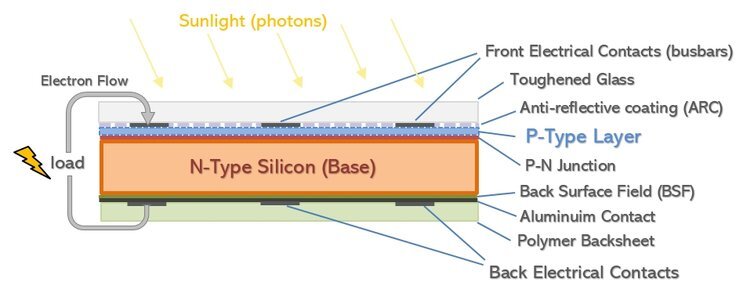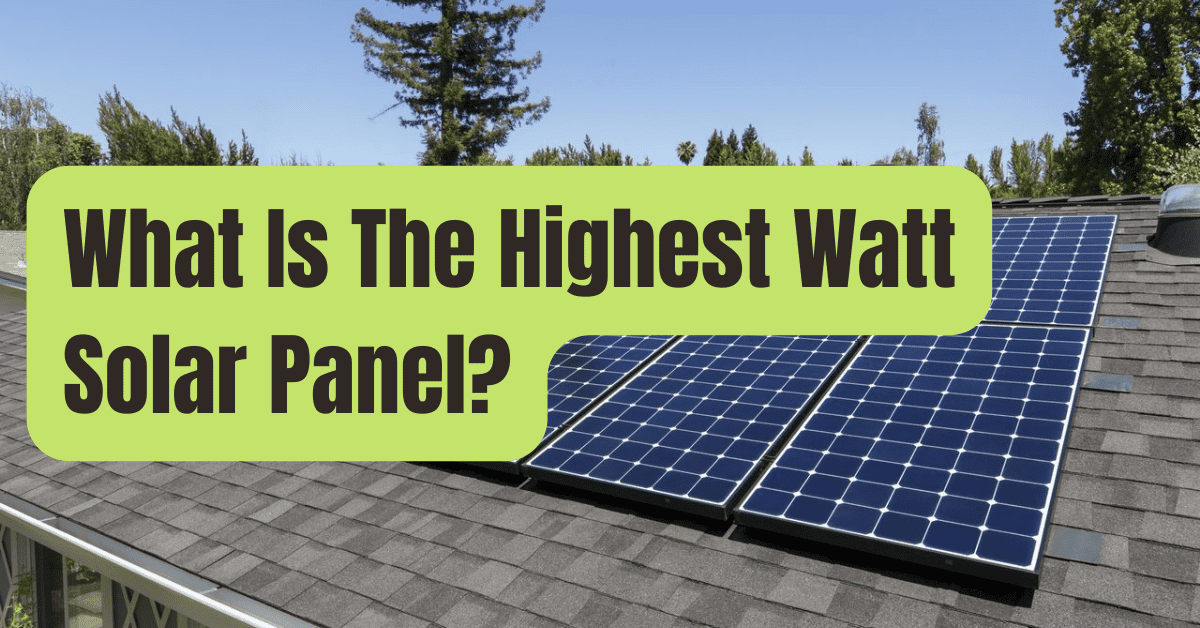Panel efficiency has typically been the area in which most solar panel manufacturers have aimed to dominate.
However, more recently, a fresh fight began to produce the world’s most powerful solar panel, with several of the industry’s largest manufacturers revealing bigger format next-generation panels with power ratings far exceeding 500W.
When Trina Solar unveiled the first panel with a 600W rating in 2020, the competition for the most potent panel officially began.
Soon after, JinkoSolar debuted a 610W variant of the Tiger Pro panel at the SNEC PV Power Expo in China.
At the same time, Trina Solar said a 660W+ panel with even more output was in development.
Surprisingly, more than 20 manufacturers displayed panels with a power rating of over 600W at SNEC 2020, with the Jumbo 800W module from JA Solar serving as the most potent display.
This panel, however, was massive, measuring 2.2m high and 1.75m wide.
The PV cell technologies that enable these greater power ratings are mostly universal, notwithstanding the hype surrounding the several high-powered panels.
The size and output of conventional commercial and residential panels have also risen, with 400W to 500W panels now being the norm.
The substantial increase in power is essentially the result of efficiency gains brought about by several technologies, which we discuss later in the essay.
#1. For Utility-Scale Systems.
The primary motivation for the development of bigger, more potent solar panels is the goal to lower the cost of utility-scale solar farms and thus lower energy rates.
Larger panels need the same number of connections and labor hours as smaller panels, which lowers the installation cost per kW and lowers total costs and LCOE.
In comparison to typical panels seen on residential roofs, the new high powered panels are physically significantly bigger, as will be detailed below.
However, anyone wanting to install a dozen 600W panels on their rooftop in order to easily generate 7kW will be somewhat let down.
The majority of high-powered panels are now only available for commercial and utility-scale systems, and their extra-large size makes them difficult to install on most residential roofs.
The front-runners in the race include Trina Solar, Jinko Solar, Canadian Solar, Risen Energy, and JA Solar, even though the solar industry as a whole is gradually transitioning to bigger, higher wattage panels.
Over the last year, all of these well-known brands have introduced super high-power panels with ratings exceeding 600W.
It’s interesting to note that premium module producers REC and SunPower (now Maxeon) are not competing to create bigger format high-power panels.
Instead, they are concentrating on selling high-efficiency panels to their regular residential and business clients.
Sunpower has nevertheless shown a bigger 540W panel in the upcoming “Performance 5” series.
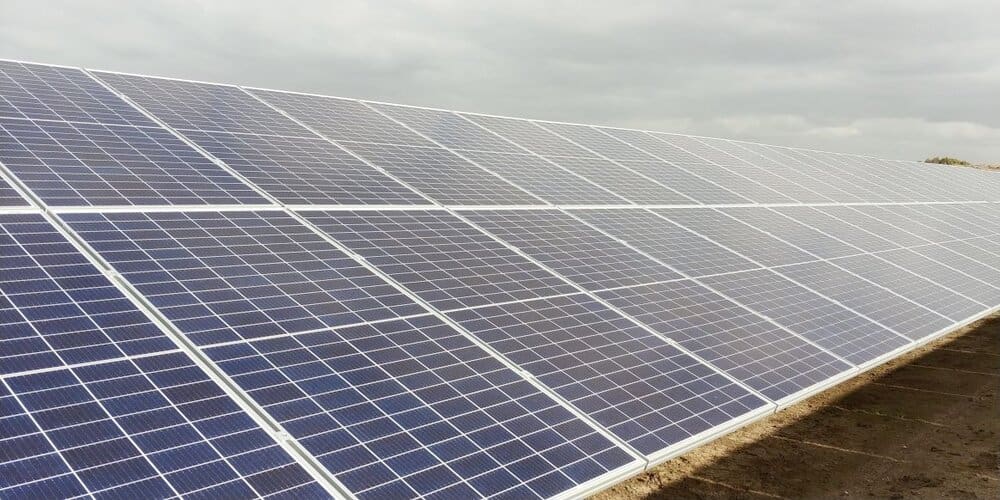
#2. The Strongest Solar Panels
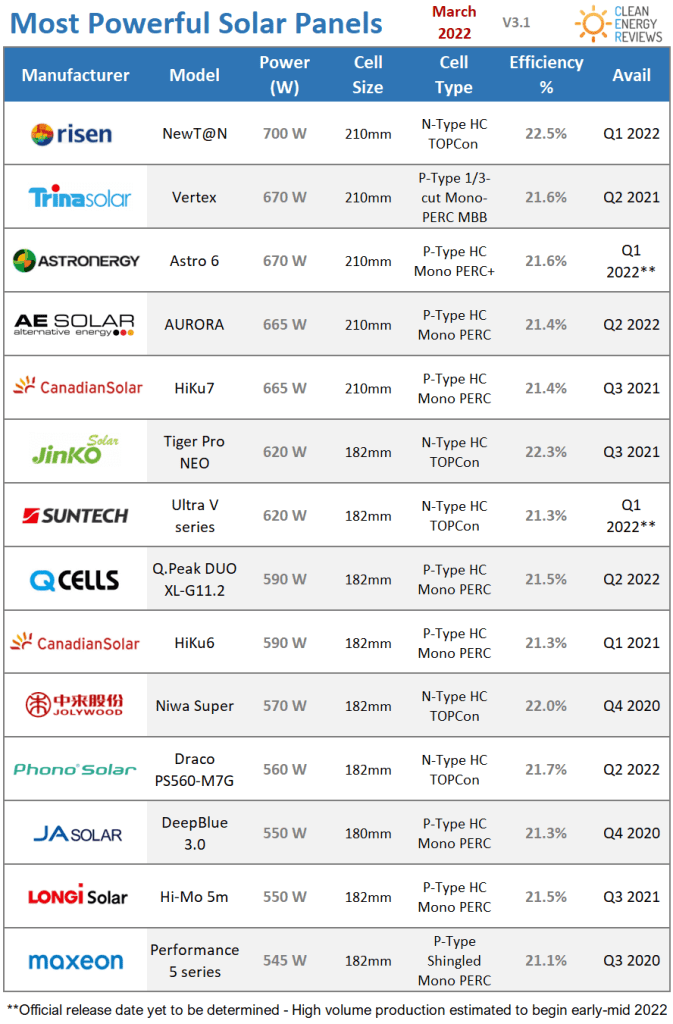
* A list of the most potent panels, with a maximum panel size of 2.4m high x 1.4m wide, that are either now in production or will be available shortly.
For various areas, availability and release dates could change.
| Make | Model | POWER | Cell size | Cell type | Efficiency % | Avail |
|---|---|---|---|---|---|---|
| Risen Energy | NewT@N | 700 W | 210mm | N-Type HC TOPCon | 22.5 % | Q1 2022 |
| Trina Solar | Vertex | 670 W | 210mm | P-Type 1/3-cut Mono-PERC MBB | 21.6 % | Q2 2021 |
| Astronergy | Astro 6 | 670 W | 210mm | P-Type HC Mono PERC+ | 21.6 % | Q1 2022** |
| AE Solar | Aurora | 665 W | 210mm | P-Type HC Mono PERC | 21.4 % | Q2 2022 |
| Canadian Solar | HiKu7 | 665 W | 210mm | P-Type HC Mono PERC | 21.4 % | Q3 2021 |
| Jinko Solar | Tiger Pro NEO | 620 W | 182mm | N-Type HC TOPCon | 22.3 % | Q3 2021 |
| SunTech | Ultra V series | 620 W | 182mm | N-Type HC TOPCon | 21.3 % | Q1 2022** |
| Q CELLS | Q.PEAK DUO XL-G11.2 | 590 W | 182mm | P-Type HC Mono PERC | 21.5 % | Q2 2022 |
| Jolywood | Niwa Super | 570 W | 182mm | N-Type HC TOPCon | 22.0 % | Q4 2020 |
| Phono Solar | Draco PS560-M7G | 560 W | 182mm | N-Type HC TOPCon | 21.7 % | Q2 2022 |
| JA Solar | DeepBlue 3.0 | 550 W | 180mm | P-Type HC Mono PERC | 21.3 % | Q4 2020 |
| Longi | Hi-Mo 5m | 550 W | 182mm | P-Type HC Mono PERC | 21.5 % | Q3 2021 |
| Maxeon | Performance 5 series | 545 W | 182mm | P-Type Shingled Mono PERC | 21.1 % | Q3 2020 |
** The precise release date has not yet been established; high volume manufacturing is anticipated to start in early to mid-2022.
Half-cut cells is HC.
2.4m high by 1.3m wide is the maximum panel size.
#3. Increased Panel Sizes
Prior to recent breakthroughs in solar cell technology, efficiency gains accounted for the majority of increases in panel power.
Although this is a contributing component to the sharp increase in panel wattage, the primary cause is the development of new, bigger cell sizes and a greater density of cells per panel.
The new panels are physically substantially bigger due to the new cell types and layouts.
In general, utility-scale solar farms or sizable commercial installations are the greatest candidates for these huge panels.
Traditionally, solar panels came in two primary sizes: the normal format 60 cell panels, which are used on residential roofs and measure around 1.65 meters high by 1 meter wide, and the larger format 72 cell commercial scale panels (roughly 2m high x 1m wide).
Then, panels of approximately the same size with half-cut cells that were 120 cells and 144 cells in size appeared.
In addition to the typical sizes, a few high-end manufacturers, like SunPower and Panasonic, produced unusual 96 and 104 cell panels.
For a large portion of the last decade, the 156mm x 156mm or 6-inch square cell type served as the industry standard for panel sizes.
However, the bigger 180 and 210mm wafer sizes provide the foundation for the new panel sizes that are coming, which may be up to 2.4m long and 1.3m broad.
Compared to conventional 2.0 x 1.0 m 72-cell panels, this is a size increase of 20 to 30 percent, which naturally explains the enormous gain in power per panel.
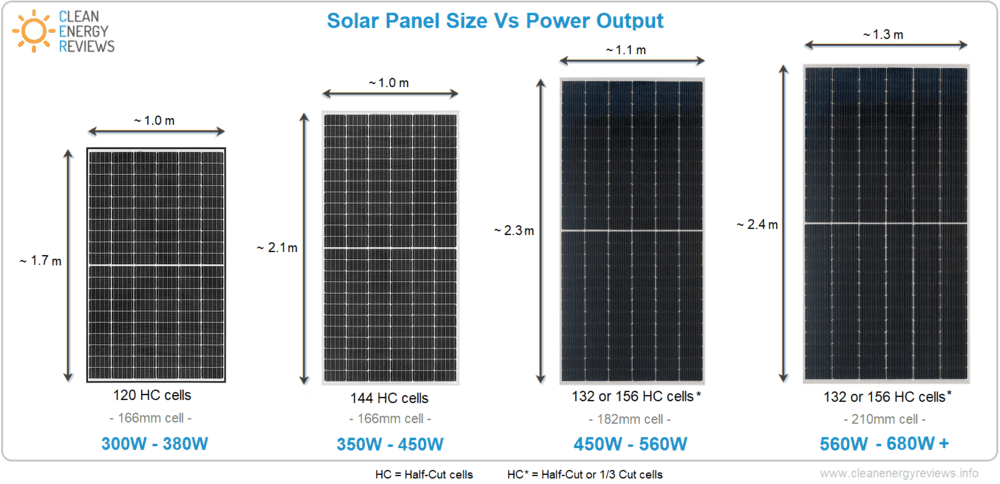
#4. Larger Sized Cells
Manufacturers shifted away from the conventional 156mm (6″) square cell wafer size in favor of bigger wafer sizes to reduce production costs and increase efficiency.
While many other cell sizes are being developed, 166mm, 182mm, and 210mm are a few that have become the current industry standards.
While Trina Solar is promoting the larger 210mm wafer size, many of the top manufacturers, including Jinko, Longi, and Canadian Solar, have aligned with the 182mm format.
Longi, the largest producer of mono silicon wafers in the world, uses both the 166mm and 182mm sizes depending on the application.
Many of the lower volume manufacturers may need to adopt one of the new wafer sizes in order to use common wafer and equipment vendors in order to stay competitive.
This thorough essay from PV Tech covers the numerous wafer and ingot sizes, technological advancements, and manufacturing trends around present-day and future PV cells to provide a thorough history and insight into wafer and PV cell sizing standards.
There are several novel panel designs developed around the various cell combinations in addition to the various cell sizes.
The 66-cell (half-cut 132), 78-cell (half-cut 156), and 84-cell (half-cut 168) panels are the three most well-liked designs that have recently developed.
The extra-large 210mm cells are especially well adapted to uncommon cell division formats such 1/3 cut cells, in which the square wafer is divided into three segments as opposed to the typical half-cut or half-size cell.
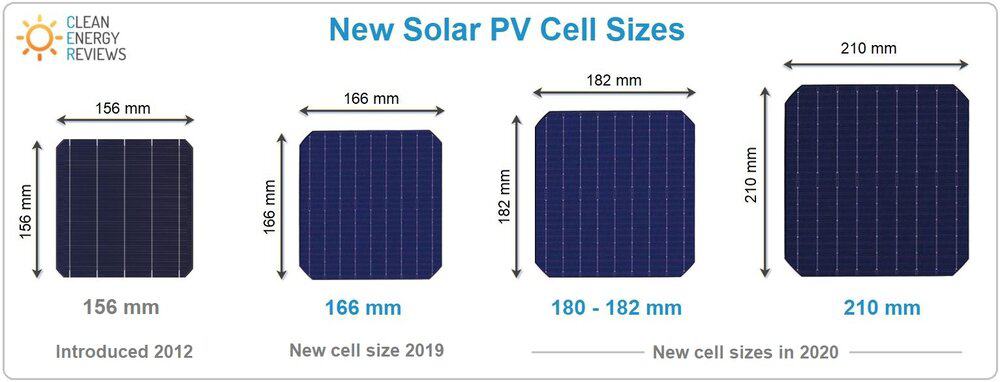
#5. High-Performance Batteries
The panels and cells have not only grown in size to reach these amazing power ratings, but cell efficiency has also significantly boosted thanks to a number of new technologies (mentioned below), as well as cutting-edge rear side passivation methods like TOPCon.
- Multi-busbars (MBB)
- Passivated emitter and back cell: PERC/PERC+
- Tunnel-Oxide Passivating Contact (TOPCon)
- Silicon N-type cells
- Lessening intercellular gaps in high-density cells
By investing heavily in research and development, several manufacturers are looking at various strategies to enhance power and improve cell efficiency.
One of the easiest and most expensive ways to increase efficiency is to employ N-type silicon.
However, as economies of scale drive down the cost of producing the high-performance N-type silicon wafers, the price difference between P-type and N-type silicon is closing.
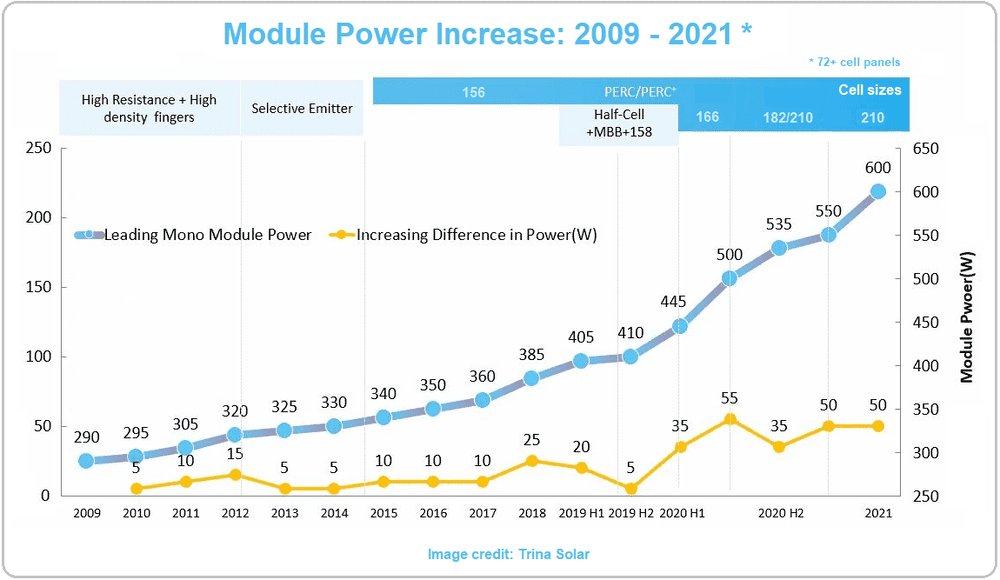
#6. Multi-busbars (MBB)
Multi-busbars have been the most widely utilized technology among the various cell advancements to boost efficiency (MBB).
Rapid phase-out of conventional ribbon busbars (5BB or 6BB) in favor of nine or more thin wire busbars (9BB).
In their new Alpha panel series, some manufacturers, like REC, have even switched to 16 micro-wire busbars.
Wider cells allow more busbars to fit on their surface, and cells with 10 or 12 busbars are also becoming increasingly prevalent.
Due to the enhanced power production by using the back side of the panel to obtain up to 20% or more power, bifacial panels with MBB are also becoming more and more common (roughly 80W extra).
Bifacial panels, however, are often only advantageous over light-colored surfaces, such as light-colored rocky or sandy ground utilized in large MW scale solar farms situated in more dry regions.
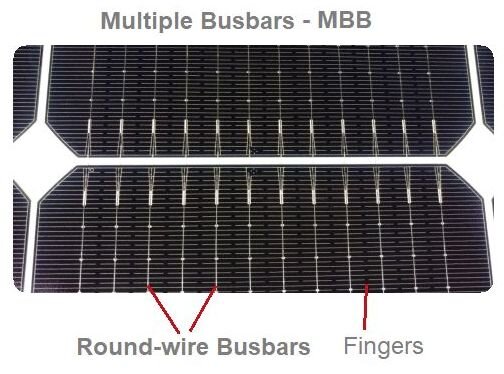
#7. Intensive Cells
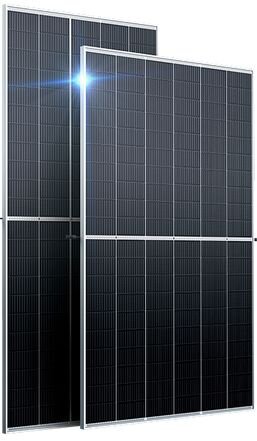
Manufacturers like Trina Solar have created methods to decrease the vertical inter-cell space between cells in order to further enhance panel efficiency and output.
More panel surface area is available to absorb sunlight and produce electricity when the customary 2-3mm vertical gaps between the cells are removed.
The most typical method used by manufacturers to minimize or remove the gap is to simply decrease the cell spacing from around 2.0mm to 0.5mm.
Traditional bigger ribbon busbars needed 2.0mm+ to bend and join the front and back of each cell, which is why there was a gap.
However, the distance was greatly decreased because to the switch to much smaller wire busbars.
Another manufacturer, LONGi Solar, was able to lower the inter-cell gap to 0.6mm using what the business refers solar as a “smart soldering” technique with integrated segmented ribbons.
With the use of a very thin, flattened segment that bends and flows behind the cell to establish the interconnection, this innovative technology employs an unusual triangular busbar design across the front surface of the cell.
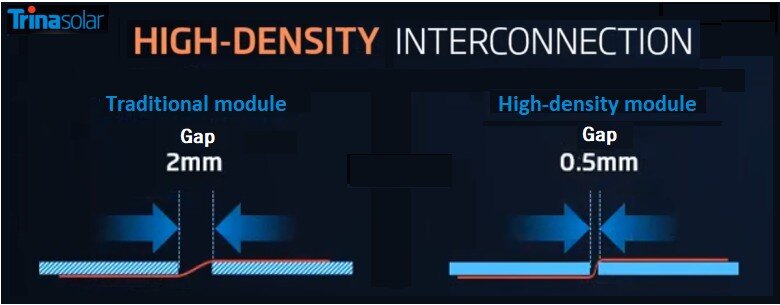
#8. Tiling Ribbon Technology, Or TR
The business known as Jinko Solar, which is presently the leading maker of solar panels, created what it calls Tiling Ribbon or TR cells.
By gently overlapping the cells to increase cell surface area, the inter-cell gap is eliminated with ribbon cell technology.
Power output and panel efficiency are thereby increased.
By employing inter-cell compression joining techniques rather than soldering, the tiling ribbon technology also significantly minimizes the quantity of solder needed.
Similar technique is utilized in shingled cell panels, such those in the Sunpower Performance series, to create bigger format, high-power panels by interlocking thin cell strips.
removing the inter-cell gap using Tiling Ribbon cell technology to increase efficiency – Image credit Jinko
Similar steps have been taken by a number of other top producers, including Q Cells, to increase efficiency by totally removing the inter-cell gap.
The majority of manufacturers, however, have adopted the more conventional strategy and have minimized the inter-cell clearance to the point where there is only a very tiny 0.5mm gap.
This successfully eliminates the gap without the need to create new cell connectivity procedures.
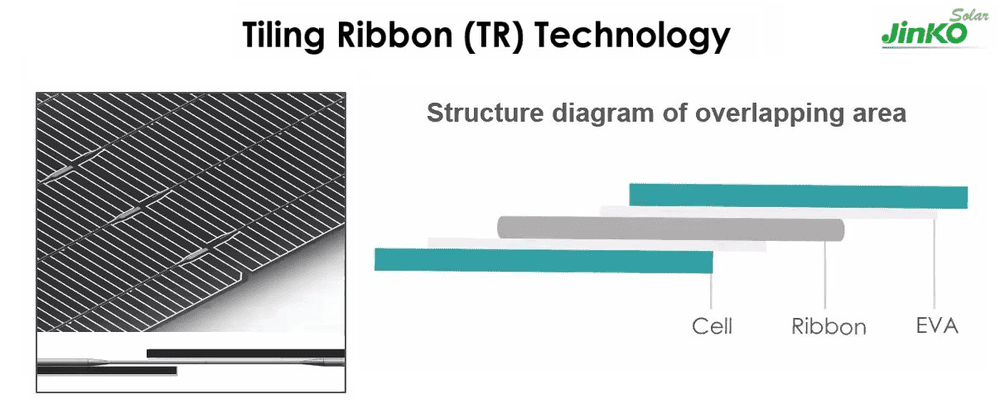
#9. Silicon N-type Topcon Cells
Due to a higher tolerance for impurities, which boosts overall efficiency, N-type silicon-based cells perform better than the more popular P-type silicon-based cells.
The temperature coefficient of N-type cells is also lower than that of mono and multi P-type cells.
Additionally, LID, or light-induced degradation, occurs considerably more slowly in N-type cells than it does in P-type cells, who often experience LeTID, or light and high temperature induced deterioration.
Tunnel Oxide Passivated Contact, or TOPCon, is a specialized rear side cell passivation technology that increases cell efficiency and reduces internal recombination losses.
The method has been available for a while, but as manufacturers look to improve performance and efficiency, it is now emerging as the new industry standard.
